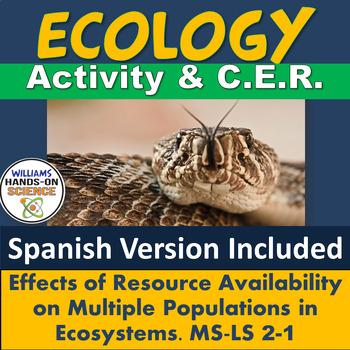Ecology Resource Availability Populations Activity Claim Evidence Reasoning NGSS
- Google Slides™

Description
This activity is engaging, challenging and NO PREP! This 90-minute activity covers NGSS LS2.A: Interdependent Relationships in Ecosystems: Growth of organisms and population increases are limited by access to resources. (MS-LS2-1)
Spanish versions included!
What Students Do:
1.Students explore multiple habitats of rattlesnakes and analyze data related to their population densities based on resource availability.
2. Students answer questions related to the data to deepen their understanding of the factors that influence rattlesnake populations in different habitats.
3. Students engage in a claim evidence reasoning (CER) activity to investigate how the California drought is causing rattlesnakes to migrate to urban areas. They will use the information gathered from the reading and the data analysis to formulate a claim, support it with evidence, and provide reasoning for their conclusions.
4. By the end of this lesson, students will have a better understanding of the impact of environmental factors on the distribution of rattlesnake populations and how human activities can influence their behavior and resource availability.
This resource includes the following:
-One page of Close Reading
-Student hard copy handout with data table and questions
-Key
-2 different CER Graphic Organizers
-CER Anchor Charts
-Article on Rattlesnakes in Urban Areas
Concepts Included:
LS2.A: Interdependent Relationships in Ecosystems
ESS3.C: Human Impacts on Earth Systems
Resource Availability in Ecosystems
Limited Resources Effect Populations and Ecosystems
Predator Prey Relationships
Interactions in Ecosystems
Resources
Food Sources
Adapt
Drought
Wildfires
Habitat
Survival
Includes the Following NGSS Standards:
Analyze and interpret data to provide evidence for the effects of resource availability on organisms and populations of organisms in multiple ecosystems. MS-LS2-1
LS2.A: Interdependent Relationships in Ecosystems
• Organisms, and populations of organisms, are dependent on their environmental interactions both with other living things and with nonliving factors. (MS-LS2-1)
• In any ecosystem, organisms and populations with similar requirements for food, water, oxygen, or other resources may compete with each other for limited resources, access to which consequently constrains their growth and reproduction. (MS-LS2-1)
• Growth of organisms and population increases are limited by access to resources. (MS-LS2-1)
ESS3.C: Human Impacts on Earth Systems
• Human activities have significantly altered the biosphere, sometimes damaging or destroying natural habitats and causing the extinction of other species. But changes to Earth’s environments can have different impacts (negative and positive) for different living things. (MS-ESS3-3)
• Typically as human populations and per-capita consumption of natural resources increase, so do the negative impacts on Earth unless the activities and technologies involved are engineered otherwise. (MS-ESS3-3), (MS-ESS3-4)
Crosscutting Concepts
• Cause and Effect: Cause and effect relationships may be used to predict phenomena in natural or designed systems.
• Systems and System Models: Models can be used to represent systems and their interactions—such as inputs, processes and outputs—and energy, and matter flows within systems.
• Patterns: Observed patterns in nature guide organization and classification and prompt questions about relationships and causes underlying them.
• Stability and Change: For both designed and natural systems, conditions that affect stability and factors that control rates of change are critical elements to consider and understand.
Science and Engineering Practices:
Asking Questions and Defining Problem
· Students at any grade level should be able to ask questions of each other about the texts they read, the features of the phenomena they observe, and the conclusions they draw from their models or scientific investigations.
Engaging in Argument from Evidence
· Argumentation is the process by which explanations and solutions are reached.
Construct an Explanation
· Based on valid and reliable evidence obtained from a variety of sources (including students' own investigations, models, theories, simulations, peer review) and the assumption that theories and laws that describe the natural world operate today as they did in the past and will continue to do so in the future.
TERMS OF USE
• All rights reserved by Williams Hands On Science, Inc.
• This product is to be used by the original purchaser only.
• Intended for classroom and personal use only.
• Copying for more than one teacher, classroom, department, school, or school system is prohibited.
• This product may not be distributed or displayed digitally for public view.
• Failure to comply is a copyright infringement and a violation of the Digital Millennium Copyright Act (DMCA).
If there are any errors or questions, please contact me through TpT or email me at:
williamshandsonscience@gmail.com
Thank you for taking a look!
Please follow me on TpT for new products and check me out on Instagram for my products in action!
https://www.instagram.com/williams_hands_on_science/





